The other day I was working with our gelding, Patches, on a liberty ritual that involves a pile of hay and him walking to me rather than to the hay. We then walk to the hay together, and include stops and sometimes backing up on our way there.


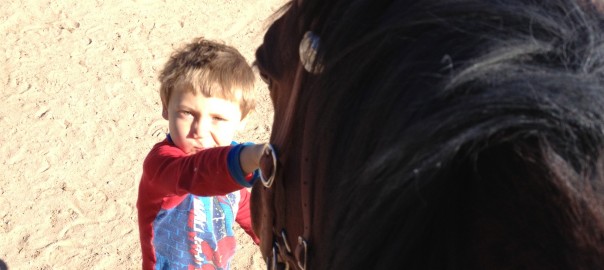
This Discovery News Channel headline: “Dogs Sent to Newtown to Comfort Grieving” caught my eye.
“Discovery News – A team of specially trained dogs just journeyed 800 miles to help grieving children and adults at funerals and other gatherings this week in Newtown, Conn.
Continue reading Interspecies bonds provide a comforting presence
Which is it: behavior or physical pain?
This question came up in a recent discussion regarding horses and is one that comes up in treatment quite frequently. My answer to this question is this: I will treat the body first and find out if there are any reasons why the horse might be experiencing discomfort. I will also ask questions about her lifestyle – whether there have been changes in living situations, feed, exercise, etc. that might impact the horse.
Some horses are very stoic and although they are lame they won’t complain about a saddle going on or being asked to work. Others may appear sluggish or balky or actually pin their ears and kick out when asked to do anything that might involve pain. They just don’t want to be messed with. If I work with the horse for awhile, problems will come up that we’ll be able to address and hopefully the behavior will go away.
If the horse is physically fit and has been checked out by a veterinarian as well, and is still experiencing what appear to be “behavioral” problems, then we need to look at what is making her unhappy. Sometimes it is the way the owner has been interacting with the horse. This doesn’t mean the owner is a bad owner, it just means possibly there is a focus on performance, or the owner is madly busy trying to pay the bills and hasn’t had any brain space to consider what the horse might need. We all find ourselves there at some point or another 🙂 Or, maybe a life change has occurred; a stablemate has gone.
An example is our horse, Patches. We purchased Patches from a Craiglist ad in August 2011 for our granddaughter, Ariana. He was advertised as a former show horse, and for the previous four years, a therapy riding horse. He knew how to do everything you asked. “Push button,” you might say. Ariana, my husband Michael and I all rode him to test him out. He was a good boy but I thought he was a little shut down, meaning I couldn’t really sense his true self.
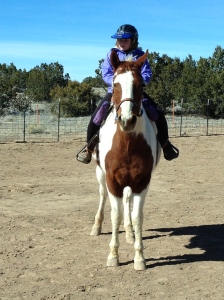 We bought him, needless to say. He is a great horse who took some time to get adjusted because he lets other horses push him around, but he’s so big and sweet you just fall in love with him, so he had a lot of support from us. He was underweight when we got him so we packed on the groceries. Now all those patches have expanded as they do with all of us in this family. He took to everything, loving
We bought him, needless to say. He is a great horse who took some time to get adjusted because he lets other horses push him around, but he’s so big and sweet you just fall in love with him, so he had a lot of support from us. He was underweight when we got him so we packed on the groceries. Now all those patches have expanded as they do with all of us in this family. He took to everything, loving 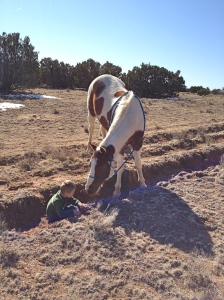 attention.
attention.
Over the winter, I began to notice some changes in his demeanor. It felt like he wasn’t able to hold it all together. He had always been cranky about having the cinch tightened, and was worse around adults, but it got so he was cranky around the kids too. I was told this cinchiness was the reason he had lost his job as a therapy horse. No one wanted to deal with him kicking out when they cinched him up. Because I’m a bodyworker, I looked at it not as behavioral but as physical. He was very constricted in the chest and sternum area, and he was a loud breather, a “roarer” as the vet would identify it. He has an epiglottal flap that closes over the larynx and impairs breathing. I began to wonder if the problem with the cinching was in some way related to this and chest restriction. He also suffered from intermittent lameness.
Patches had been tenderfooted after trims and one day he kept lying down. The next day he was not eating, and it turned out he had pneumonia and spent the next two days after that in the horse hospital.
For his rehabilitation I worked on him a small amount each day for a couple of weeks to bring him back around. We didn’t ride him because we wanted him to not have any pressure, so took him for walks and let him graze. We did liberty work with him. To work with resistance, we set up situations that he would not have to resist.
What I also notice is that he loves to perform. He loves children and will want them in the saddle before an adult, but he is so affectionate he will put up with adults very nicely. He still has the roaring but I have him on an herbal supplement to reduce that and he is doing well.
I believe there were several things at play here. First of all, Patches may have been getting sick while he was a therapy horse, but people regarded his problems as behavioral. Some inflammation can remain residual in the body for years so he could have been sick in a way that would not show up on any tests. Secondly, not feeling well leads to a change in behavior and from that patterns emerge that may end up getting stuck and not resolve themselves without help.
When a horse begins acting crabby about something, it’s time to take stock of the whole picture, not just say, oh, he’s grouchy. Ear flattening, kicking out, biting, striking, bucking can all indicate that a horse may be experiencing pain that is unseen to us. I was recently working on a mare who travels beautifully, no lameness, no back soreness, yet when I went to lift her hind leg, she wrenched it away from me repeatedly. It has taken a couple of sessions for her to let me even touch the hind leg. There was pain at the hip and there is a small amount of atrophy in the gluteal muscles on the same side of the haunch. This is unusual for a horse that is getting good exercise and turnout. Yet attention needs to be given to this even though she travels well and isn’t lame, because it’s hurting her.
What is good about this situation is the horse can remain in training yet receive bodywork to heal from within. Already after a couple of sessions it’s much better. Sometimes, however, a horse will need to be pulled out of training just to let the body heal, either physically or mentally, or both. That’s what we did with Patches, however, we were still able to do Liberty Foundation Training with him during that healing time.
In another case, a mare didn’t want to walk fast. I felt no restriction in her body when I did bodywork on her, so we did a small amount of liberty work on her and her owner reported that she is walking out now. There are some things we can do for follow-up, to keep that enthusiasm in the walk, to keep it all lively and interesting.
This dual approach has one thing in common: in Ortho-Bionomy/Equine Positional Release bodywork, a primary focus is to “meet” the individual where they are. The same is true of the Liberty Foundation work: we start where the horse is, we do not start with our own agenda. This is why some piece of the issue can be addressed by bodywork, and another piece addressed and reinforced by the foundations.
If you think your horse would benefit from this approach, contact me to set up an appointment. susansmith@orthohorse.info 505-501-2478
(copyright Susan Smith)
In Ortho-Bionomy study we talk about the study as the “Evolvement of the Original Concept.”
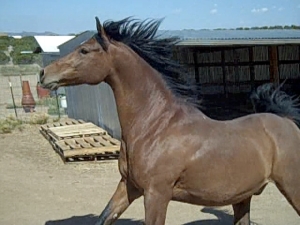 Continue reading Embodiment – understanding at the cellular level
Continue reading Embodiment – understanding at the cellular level
The dreaded words, “You need a new saddle,” strike fear in the hearts of everyone who owns a horse. This advice is usually greeted by protests, “but it has fit her for years,” “I had this saddle custom made, it has to fit,” “my vet says it absolutely fits,” “I can’t afford another saddle!” and on and on.
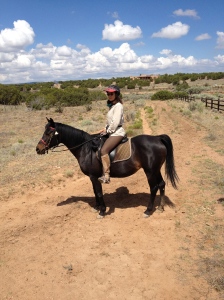
I have had this dressage saddle for a number of years, but usually ride in my endurance saddle. Lately I haven’t ridden in it because my right leg kept coming out of the stirrup, particularly at the trot. I was thinking I’d have to sell the saddle even though it fits my mare Zuzka, really well, and I like the feel of it otherwise.
Then I rode in it the other day, and I was happily surprised that the right leg was no longer dropping the stirrup! What I surmised had happened was the femur, the long thigh bone, was not properly seated at the base of the ilium, the big bone of the pelvis, which caused the fibula in the lower leg to lose its place, so the leg flopped out.
It got me thinking about how we/I think that something is going to remain that way forever, once it sets in, sort of like a mindset, where we consider that now the leg is going to drop the stirrup and it will never get any better just because…
Dr. Arthur Lincoln Pauls, founder of Ortho-Bionomy, was interested in addressing what he called “crystallized forms” – where we think there is no choice. He wanted to explore what was beyond those crystallized forms – where could the body go if we allowed it choice, to find its own path of self-correction. Our minds, trauma, all sorts of things, can sometimes stand in the way, blocking the way to breaking down those crystallized forms of our thinking and in turn, what our bodies can and will do.
I receive Ortho-Bionomy on a regular basis. One of the things I tell clients yet forget myself is that many times we come for treatment of one particular ailment, but while that is being addressed, other ailments or problems may fall away. I have not gone to an appointment with the sole purpose of doing anything about my leg, for instance, because I had another saddle to ride in where this didn’t happen. I thought I was probably just getting older (perish the thought) and this was the new normal.
I know I’m not alone in that kind of thinking. It’s natural to tend to the things that are the most problematic. But what if we could achieve what seems beyond the body’s current ability, not shoving it around in a repetitive exercise class or judo, or insisting on lifting 100 bales of hay, but by just giving it time and encouragement to make the corrections it needs to make? And sometimes, I think, by forgetting about a problem, as I had, it gives the body the space to make a change. “Whew, she isn’t eyeballing me any more. Now I can relax.” [body part speaking]
It shows me that so much healing takes place while we’re busy making other plans, sort of like life. If we’re busy healing one part, then the others will join in if they can. We use the pause or “the space between the notes” in Ortho-Bionomy — where we allow a rhythm to continue or establish itself, whatever the case may be, that can lead to healing.
It reminds me too of how in liberty training in the Carolyn Resnick Method, we use “the pause,” and in it, we also sometimes turn away from the horse, find something else to do, so we don’t have all our attention boring down on him. He may find this interesting and come over to check it out. New thought patterns emerge out of curiosity. The horse becomes more of himself, curious, alive, wanting to engage.
So we can see how horses do not like crystallized forms. They want us to be leaders, but true leaders, who are always looking for the best way to communicate. By giving space in the relationship we hear what the horse has to say. We learn true leadership, so that horses want to do activities with us, which is what we would all want in a relationship. Why wouldn’t our horses appreciate that treatment?
If I remain open to possibility, to breaking down those crystallized forms with people and animals, there is a greater chance of touching the unknown, receiving gifts I didn’t know existed – and possibilities beyond my wildest dreams.